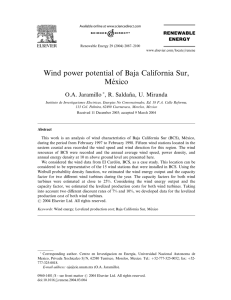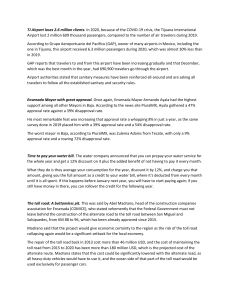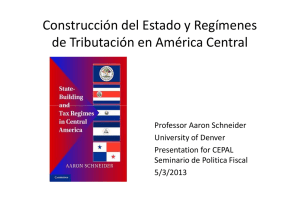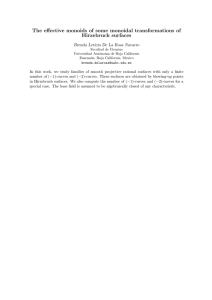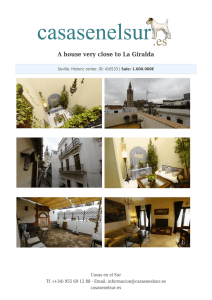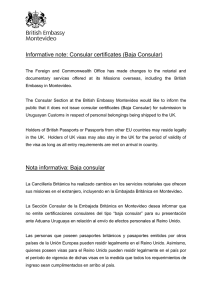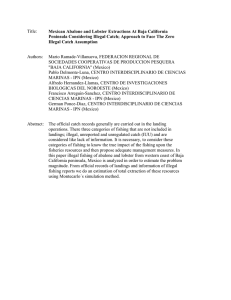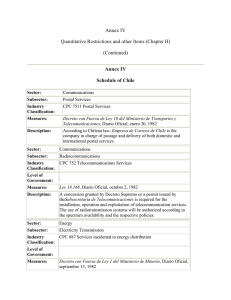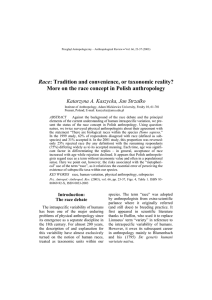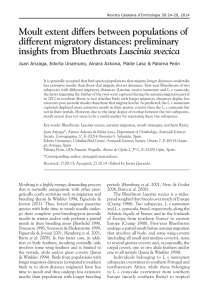Status of an endangered subspecies: the peninsular pronghorn at
Anuncio
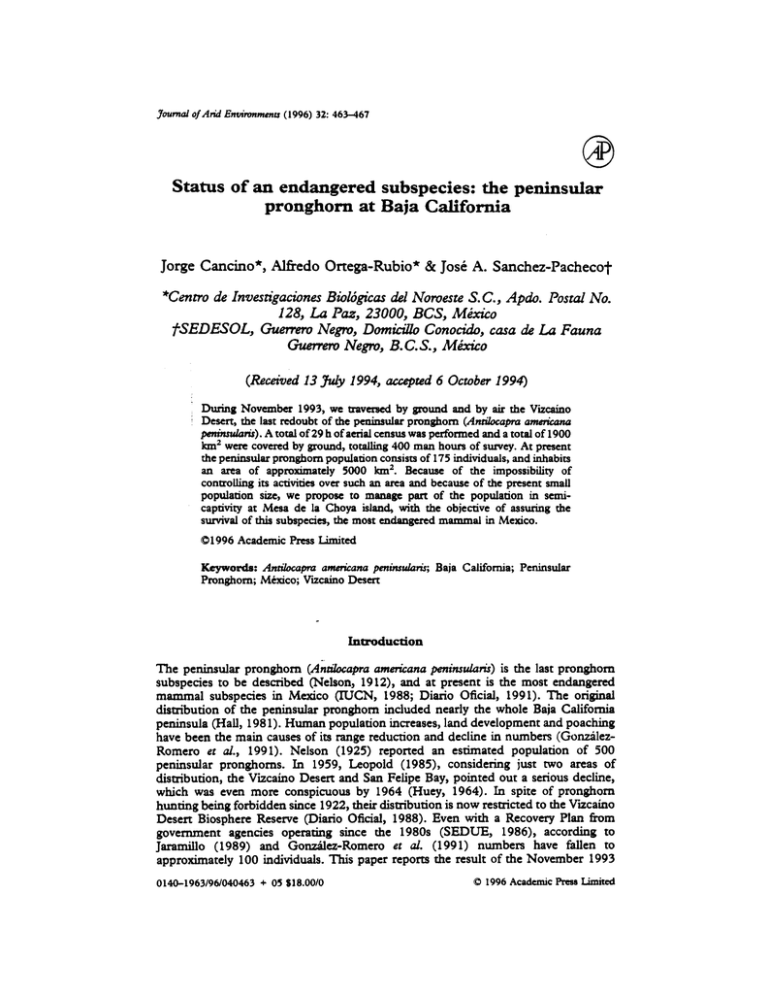
Status of an endangered subspecies: the peninsular pronghorn at Baja CaLifornia Jorge Cancino*, Alfiedo Ortega-Rubio* & José A. Sanchez-Pachecot *Cenno de Investigaciones Biológicas del Noroeste S. C., Apdo. Postal No. 128, La Paz, 23000, BCS, México fSEDESOL, Guerrero Negm, Dornicillo Conocido, casa de La Fauna Guewnr, Negm, B. C.S., M k o During November 1993, wc travmKd by ground and by air the Vucaino Desert, the last redoubt of the peninsular pronghom (Anharpra ammkww penmnrhris). A totd of 29 h of aerid census was performed and a total of 1900 km2 werc covercd by ground, totalling 400 man hours of swey. At pment the peninsular pronghom population consista of 175 individuais, and inhabits an area of approxlrnatcly 5000 km2. Because of the impossibility of controlling its activities o v a such an arca and because of the pment srnall popuiation size, we propose to msnagc pan of the population in semicaptivity at Mesa de la Choya island, with the objective of assuring the survival of this subspecies, the most cndangcred mamrnal in Mexico. 0 1996 Acadernic Prcss Limitcd Keyworb Antüocapm amkana penincuhris, Baja California; Peninsular Pronghom; MCxico; Vucaino Dcsm The peninsular pronghom (~ña~ocapra americana peninrularis) is the last pronghom subspecies to be describcd (Nelson, 1912), and at present is the most endangered mammal subspecies in Mexico (IUCN, 1988; Diario Oficial, 1991). The origPnal dismbution of the peninsular pronghom included nearly the whole Baja California peninsula (Hall, 1981). Human population increases, land development and poaching have been the main causes of its range reducrion and decline in numbers (GonzálezRomero et d., 1991). Nelson (1925) reponed an estimated population of 500 peninsular pronghoms. In 1959, Leopold (1985), considering just two aseas of dismbuaon, the Vizcaíno Desert and San Felipe Bay, pointed out a serious decline, which was even more conspicuous by 1964 (Huey, 1964). 1x1 spite of pronghom hunting being forbidden since 1922, their dismbution is now resmcted to the Vicaíno Desert Biosphere Reserve (Diario Oficial, 1988). Even with a Recovery Plan from government agencies operating since the 1980s (SEDUE, 1986), according to Jaramillo (1989) and Gonzáíu-Romero et d. (1991) numben have fallen to approximately 100 individuals. This paper reports the result of the November 1993 0140-1963/96/040463 + O5 $18.0010 Q 1996 A c a d d c Rces Limitcd census, with the highest number counted since 1977. Information in censuses ftom 1977 to 1993 is summarized, and management of pan of the population as an urgent measure for recovery of the subspecies is proposed. Materials and methods As pan of the Federal and State activities for proteaion for this subspecies (SEDUE, 1986), aenal and terresmal surveys were carried out during 15-20 November 1993 in the Vizcaino Desert (Fig. 1). Aenal survey was undertaken with a Cessna 182 plane with one pilot and two observers; we Aew in west-east mnsects at an average height of 100 m, with 1000 m between transects. Terresuial surveys were camed out by three ground teams. Each ground team induded one vehicle with two observers, each equipped with 10 X 50 binoculars. S w e y s began at 0600h, driving the vehides ftom north to south at an average speed of 60km h-', and ended each day at 1900h. A total of 200 aenal transects was perfonned in 29 h of flight, covering an area of approximately 3000 km2. The terrestrial survey covered 1900 km2. Each observation of pronghorns was recorded with date, time of day, size group, sex and age composition, location on maps (1 :100,000) (Crumpton, 1991) and direction of íiight. Location from the airplane was obtained with a Global Positioning System instrurnent. Both ground and aenal records were plotted, conuasted, and analvsed separately to avoid double counts. The total number of pronghoms observed were 117 and 151 individuals, for the ground and aerial surveys, respeaively (Table 1). The ratios of males to females were 66: 100 for the ground suntey and 140: 100 for the aerial suntey. The total of both survevs, discounting double counts, was 175 individuals, with a male to female ratio of 85: 100 (Table 1). The results for sex and age composition of the peninsular pronghom population were 48 adult males, 56 adult femaies, and 7 1 undetermmed (Fig. 2). It is irnportant to emphasize that such a population size is the maximum recorded since 1925 (Nelson, 1925; Jaramillo, 1989; González-Romero et d.,1991). Such a population size for the peninsular pronghom enables us to propose some management practices which were not practicable with a smaller population size, since they involved the capture of several individuals. Because of poaching and the possibility of catasuophic changes, such as severe drought, in the factors that support the present population, we propose to capnire 30 adult individuals: 12 males and 18 females. The capture of su& individuals will be perfonned with two objectives: (i) to mark with radio-transmitters 10 maie and 10 female individuals, and (ii) to maintain in semi-captivity two males and eight females at La Mesa de la Choya island (Fig. 1). Marking individuals with radio-transmitters will be ve. helpful in following the seasonal movements of the population, a key factor in understanding the ecology and biology of the subspecies. Evidence exists that indicate irnportant seasonal population movements, for instance when more than one census has been camed out in the same year, the summer figures are lower than during any other season Uaramillo, 1989). Since the same zones were searched in those censuses at diñerent seasons, the pronghoms must have moved to unknown places during the sumrner. We are certain that a radio-mcking snidy would be useful in establishing the precise dismbution and seasonal movements of the population. Expenence and severa1 options are already available (O'Gara & Yoakum, 1992). Mesa de la Choya is an artificial island fonned by the development of an evaporation STATiJS OF THE P E N I N S W PRONGHORN 465 basin for sait production. Its area is approximately 10,000 ha, with controlled access. We can be sure that the main pronghorn population will be able to reproduce successfully, as the size of the population will still be above the minimum population previously reponed (Jaramillo, 1989; Gonzalez-Romero et al., 199 1) . However, if the main population in freedorn is exterminated by uncontrolled hunting, other human-related causes, or by any environmentai catastrophe, the \, Ay- -<; \ IQ Oio de Liebre , / Figure 1. Location of the Vucaino Desert and La Mesa de la Choya island. Table l. Results of some surveys on the Peninsular Pronghorn population at the Vizcaino Desert, Baja California Sur, ~Mexico, 1977-1 993. (A=aenal census; S=ground survey) Year IMonth - Survey type Toca1 countrd .Maie:female Source* --- 1977 1982 1988 1993 Feb Jan .Mar Nov S S S AS 83 39 48 175 97: 100 69: 100 65:lOO 85: 100 (1) (1) (3) This paper *(l)Jaramillo(1989);(7) Gonzalez-Romero ct d. (190 1). Figure 2. Sex and age composition data of the Peninsular pronghorn population, November 1993. (3= males; IJ = females; = undetermined). survival of the endemic subspecies will be assured by the protected population on the Mesa de la Choya island. This 5mdy was carried out wirh the support of the Centro de Investigaciones Biológicas del Soroesre (CIBSOR), the Consejo Nacional de Ciencia y Tccnoltiqía (COSACyT) projrct So. 0639x91 10, the Delegación Estatal at Baja Califomia Sur of the Secretaria de Desarrt,llo Social (SEDESOL) and the Compariia Esporradora de Sal íESSA'i. We would like rn rhank Professor John Cloudsley-Thompson and one anonymous referee for their suggestions which improved earlier versions of this manuscnpt. We rhank Sandra Lanham (Environmental Fiying Services) for her excellent piloting. - Crumpton, L.S. (1991). Baja Explorer Topographic Atlas Directop. San Diego, Ca. USA: Alti Publishing. 350 pp. Diano Oficial (1991). Acuerdo por el que se establecen los creitenos ecológicos CT-CERN001-91 que determinan las especies raras, amenazadas, en peligro de extinción o sujetas a protección especial y sus endemismos, de la flora y fauna terrestres y acuáticas en la República ,Mexicana. Diario Oficial de la Federacwn, 452 (12): 7-35. Diario Oficial (1988). Decreto por el que se declara la Reserva de la biosfera El Vizcaíno, ubicada en el Municipio de Mulegé, B.C.S. Dianb Oficial de la Federacwn, 422 (22): 2-27. Gonzalez-Romero A., Cancho J., Galina P. & Alvarez-Cardenas S. (1991). El berrendo peninsular Antilocapra americana peninoulatlr, In: Ortega, A. & h a g a , L. (Eds), La Resenia de la Biosfera El Vizcaino en la Peninsula de Baja Califomia (Publ. No. 4.), pp. 295-3 1 1. A.C. Baja California Sur, Mexico: Centro de Investigaciones Biologicas de Baja California Sur. Hall, E.R. (1981). The Mammclls of North Ameriea, Vol. 11 (2nd Edn). New York: John Wiley. 1181 pp. STATUS OF THE P E N I N S W PRONGHORN 467 I-Iuey, L.M. (1964). The Mammals of Baia Califomia, Mexico. Transacrions of rhe San Diego Society of ~VanrrdHistoy. 13: 85-1 68. IUCN (1988). Red Lisr of Threatened Animals Cambndge, U.K.: ~nternational Union for Conservation of N a m e and Natural Resources. 19 pp. Jaramiiio, F. (1989). Conmbucion al conocimiento y conservacion del berrendo de Baia Califomia (Annlocapra americuna peninsuíaris, Nelson 19 12: Amilocapndae, .Mammalin) en el Desierto de Vizcaíno, Baja Califomia Sur, ,Mé,co. Tesis profesional, Universidad Nacional Autónoma de México. 140 pp. Leopold, A.S. (1985). Fauna silvestre de .México. Instituto *Mexicano de Recursos Naturales Renovales de .México. 673 pp. Nelson, E.W. (1912). A new subspecies of pronghom antelope from lower Califomia. hceedings of the Biological Society of Wushington, D. C., 25: 107- 108. Nelson, E.W. (1925). Status of the pronghom antelope, 1922-1924. United States Depamnenr of A g w u h r e , Washingwn, D. C. Depamnenr Bullerin, 1346: 64 pp. O'Gara, B.W. & Yoakum, J.D. (1992). Raghorn management guide. Pronghom Antelope Workshop. Rock Springs, WY. 101 pp. SEDUE (1986). Secretaría de Desarrollo Urbano y Ecologia. Censo del berrendo de Baja Califomia. Informe interno. Delegación enatal en Baja Califomia Sur. 7 pp.
